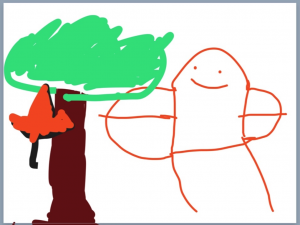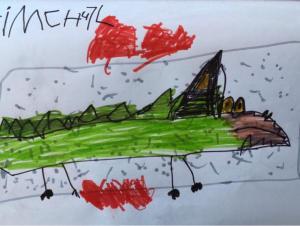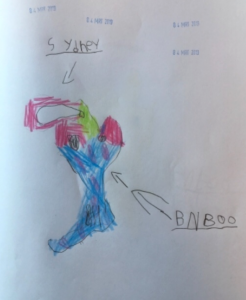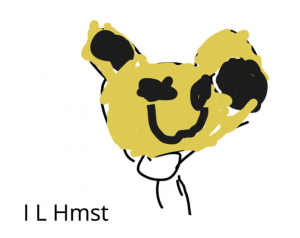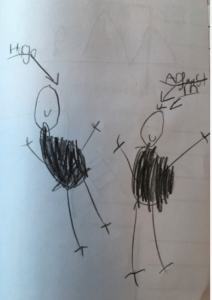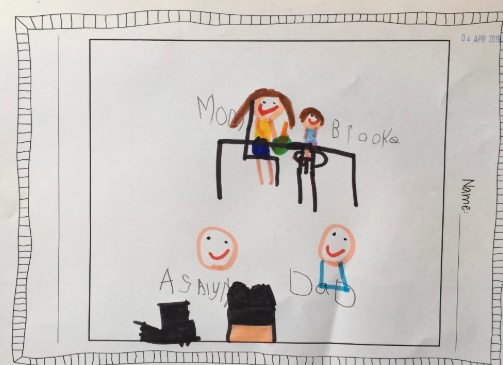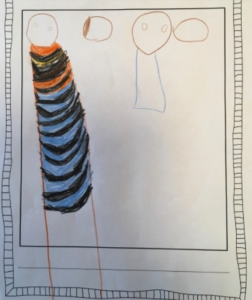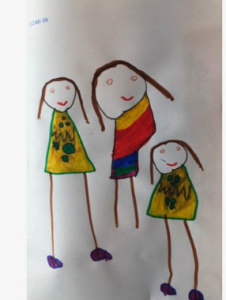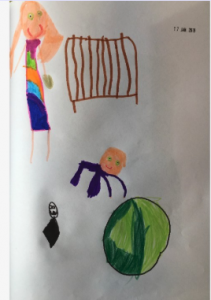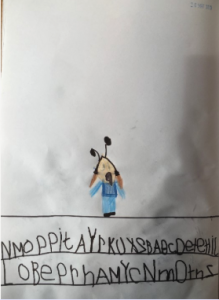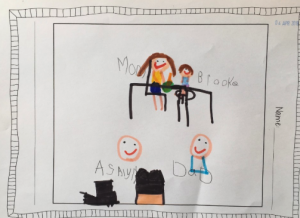The video that I am sharing in this post was filmed about two months into the school year. I wasn’t even in the classroom at the time but I am so glad that our assistant teacher sensed that the moment was one to document. It has been my inspiration as I work to facilitate the development of Kindergarten writers ever since.
Background:
Jude worked on this story over the course of at least six writer’s workshop sessions. At the time, my overall goal for the class was to move from static pictures (this is my family) to pictures that tell a story (this is the time my family was picnicking at the river and a bunch of birds got into our food). The conceptual understanding that stories move through characters and events was one that this group was ready for. As they developed their understanding, we worked on drawing skills, such as focusing on the shapes and colors of the characters, to help them effectively communicate their ideas to their readers.
Jude came to Kindergarten already understanding that stories include characters and a series of events. Research has told us time and again that literacy is best supported at home by reading aloud to our children and enjoying and consuming a variety of texts together. I never felt the need to ask because I’m pretty sure that Jude’s home life is infused with rich experiences delving into stories with his family. The story in the video exhibited way more than he could have picked up in his short school career. Not only did he demonstrate an understanding of the role of characters and events, but Jude also demonstrated an understanding of problem/solution, one of the most common story structures. He knew that he had to create an appropriate setting. He knew that his story needed a satisfying ending. He had an idea of how he wanted his story to affect his reader. He was committed to the task with absolutely no mandates from the adults in the room.
Researching the writer:
I came in on this story in the planning stages. Jude was drawing pictures of the wolf, which could have easily been mistaken for static pictures. However, on this day, I sat down beside Jude for a conference and learned that there was so much more to the wolf. Jude told me that the wolf was in the forest and that he, the main character, was scared when he saw the wolf. I could sense that Jude was still considering how far he would take this drawing and I thought carefully about how to move this writer further. I asked, “so what did the character do?” Jude told me he wasn’t sure yet. I stayed silent. A few breaths later and as he continued to work on his drawing, “no, wait, he’s gonna trap the wolf.”
“Ohhh!” I asked Jude to tell me how the story went again, checking if he would hold on to the series of events. In a way that only a writer who truly owns his idea can do, Jude told me his story, in the third person, as if he was reading it straight out of a book. I don’t need to type it here as it was not much different from the story you hear him reading in the video.
Deciding on a teaching point:
I considered my options for leveraging Jude’s enthusiasm and momentum. I could introduce code, suggesting that he label some of the pictures, “Jude” and “the wolf”, perhaps. But I hadn’t seen Jude make a move towards print yet and knew that it would come when he was ready. Instead, I opted to go a different route, one which I hoped would support his efforts to tell stories which included a series of events. One which I hoped would equip him to continue telling stories just like this one, whenever he wanted. I chose to help him explicitly recognize his events by telling his story back to him over the fingers of my hand, tapping one finger for each event. He caught on right away so I kept going. I introduced him to the idea of making a booklet when he noticed that his stories had more than one event. We talked about how each finger meant that we needed to turn the page. The result can be seen in the video, alongside all of the amazing thinking Jude did all on his own. He continues to turn the pages with events in his stories and is also experimenting with turning the page when writing information.
Where is this writer now?
Jude continues to love reading and writing stories. He also engages in the creating and sharing of stories in other ways. Our class is at least three puppet shows richer due to his imagination and his play often results in a story unfolding, be it in the building area or role-play center, the art corner or at recess.
Jude’s ability to encode his ideas has developed steadily as well. He knows where to find the words he needs if they are familiar to our class and he has an age-appropriate understanding and use of letter-sound relationships. However, I have noticed that these are most evident when he has an idea that he is passionate about sharing. An idea that came from him. When asked, he will dutifully produce words on the page but at this point, asking him to do so often brings an obvious and unnecessary frustration which impedes his creativity and stifles his enthusiasm. In a field where it has become clear that literacy is so much more than encoding and decoding, where it has been proven that jumping to code and valuing the use of code as an indicator of literacy development is inappropriate and often even detrimental to our youngest learners, Jude is a powerful reminder that there is so much more.
As I already said, I am so grateful that this writer was captured on video but he is not alone. He represents the countless young learners who are investigating their world through and with language. It is a powerful reminder of how much there really is to language and literacy development and how, in the early years, it is vital that we don’t let the rush to learn letter names and sounds impede the rich experiences that will serve to support and motivate a move towards print as and when students are ready.

